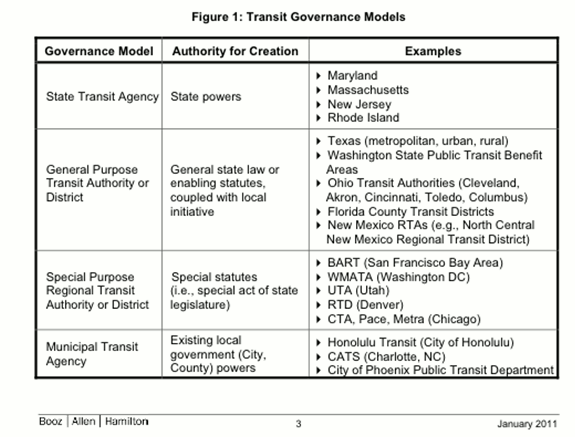

These transformations generally follow three steps: 1) recognizing the need to change, 2) analyzing available mechanisms for change, and 3) effecting governance changes.
Booz acknowledged that over the course of the last forty years population growth in both metropolitan and regional areas of the United States has continued to fuel transit demand in locations not being adequately served by public transit agencies. While the number of passengers (actual and willing) swelled, disparate public transit agencies did not always keep pace with the challenges and opportunities presented by the growth in regional travel. This occurred for many reasons: perhaps transit agencies lacked the fiscal resources; maybe politicians saw no compelling need to provide transit services beyond existing service boundaries; or provide them at all. Maybe poor planning was to blame? In any event, funding was often not readily available to support new or expanded transit services.
Advertisement
In NSW the challenge is different but not too different. The railways are publically owned by the one state authority, Rail Corporation of NSW, managing (management would argue) as best they can, a system stretching into nearly every nook and cranny in the premier state.
Its operations - running costs and frequency of services - are subject to unnecessary political interference, which regrettably often drowns out crucial decisions of how to best ration scarce public capital and replaces such conversations with cheap, shallow and unproven appellations such as “this is the first step to privatization”. As the Shadow Transport Minister, Penny Sharpeshrilled on Tuesday.
I can already envisage the ad campaigns against the reforms. Opportunistic and cunning politicians from both sides of parliament in cahoots with their financial backers will no doubt bankroll a media blitz. In one scene there’ll be a young, tall, athletic and pretty university student with her cascading chestnut hair partly concealing her large steel blue eyes sitting cross legged on a lounge in her small inner Sydney shared flat, nursing a hot Milo while enjoying some facetimewith Mum and Dad, and in another scene there’ll be Mum on the farm outside Moree or Dubbo slaving over a hot stove, cooking tea and with dear ol’ Dad by her side, imploring: “Minister: Don’t get between our girl and us. Don’t break our link. Save CountryLink”.
Assuming the government weathers the anti-reform storm, how will it manage the potential multiple parts of NSW Trains? As one body or as several units? Granted that passengers’ demands must be met, services need to be coordinated, and funding shortfalls covered, a variety of approaches are available.
According to Booz, transit authorities in the United States have transformed themselves only when pressures were great for change. These can be internal (such as organizational dysfunction) or external (such as appalling customer service or unreasonable funding needs). NSW is no different.
Steps along the path to transformation are simple. recognize the need to change; analyze the available mechanisms to change governance; and effect the governance change.
Advertisement
In summary, the Booz report nudges towns, cities and counties to recognize the need for a governance change and to take the initiative of starting the process. Can the desired changes be reached without a governance change? If so, alternate approaches are likelier paths of least resistance. More often than not, pursuing governance change is the only option. Of course the path of least resistance is to do nothing, but on the evidence to date, Premier O’Farrell and the proactive Minister for Transport, Gladys Berejiklian are not going to ape sixteen years of Labor inactivity.
Reasons for a change in the way in which transit authorities operate include one or many of the following: change in travel demanded; service coordination; customers’ expectations; hard to remove caps on ticket prices and out of control costs.
In layman terms the issues in NSW (as far as one can see as a passenger) are:
Discuss in our Forums
See what other readers are saying about this article!
Click here to read & post comments.
2 posts so far.